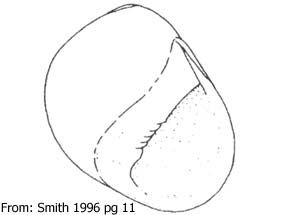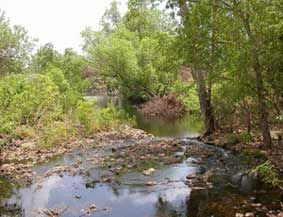Major Group: Gastropoda
Order: Neritopsina (formerly Cycloneritomorpha and Neritomorpha)
Family: Neritidae
Aquatic species in Australia belong to a single family, Neritidae. |
Descriptive Features: operculum present
operculum thick, heavy, calcareous, with large calcareous peg at the base
shell coiled, although coiling can be much reduced, to limpet-shaped
shell translucent to opaque, typically white or yellow
spire short to absent, very low, incorporated into body whorl, “neritiform”
aperture D-shaped in coiled taxa
eyes in short stalks on outer sides of tentacle bases
Total length: minute to large
|

|
Neritidae |
|
|
|
Taxonomic Checklist: Genera
Clithon oualaniensis Lesson
Neritina pulligera Lineaus
Neritina variegata Lesson
Neritina violacea Gmelin |
|
Distribution: N Qld, N NT
Sensitivity Rating: none
Functional Feeding Group: scrapers |

|
Gerowie Creek, Kakadu NP NT |
|
|
Ecology: Instream habitat: Neritidae species mainly occur in the marine intertidal area but a few species are found in brackish and freshwater lotic habitats. They are found at stream margins on rocks and wood. In Northern Australia, these snails can be common with a wide salinity tolerance but they are rare in NSW.
Feeding ecology: Neritid snails are herbivorous and presumed to feed by scraping algae and diatoms.
Habit:
Life history: Some larvae have a planktonic phase although some species may have direct development. |
| |
Information Sources: Ponder 2001, 2013, Smith 1992, 1996, 2002a, Ponder et al. 2000, Beesley 2008
Key to Genera: none
Key to Species: none |
|
|
|